Recent Posts
How Did Mold Get Here?
3/6/2025 (Permalink)
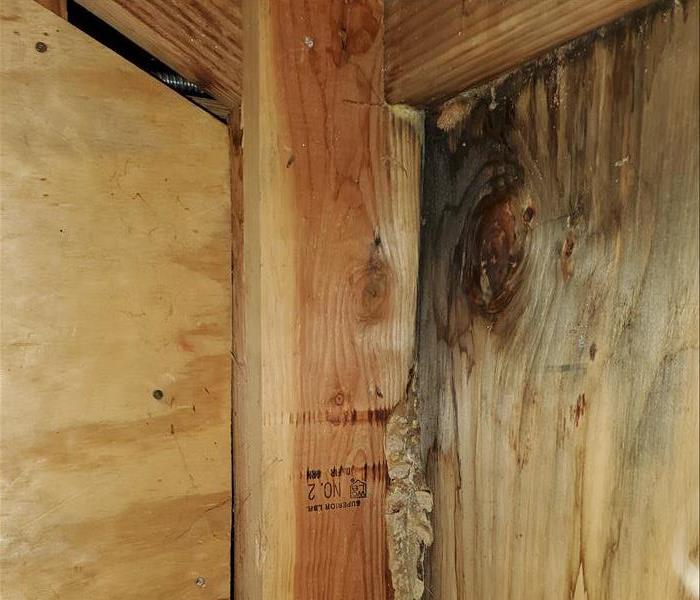 Close-up image showing mold growth on a wall with visible black spots and discoloration, indicating the presence of moisture damage.
Close-up image showing mold growth on a wall with visible black spots and discoloration, indicating the presence of moisture damage.
Mold is an opportunistic organism that grows by digesting and destroying the material it thrives on. It can be found virtually anywhere and can grow on almost any surface as long as the right conditions are present. Mold needs three key ingredients to grow: oxygen, moisture, and a suitable material to feed on. Once it has these, mold reproduces by releasing spores into the air. These spores are microscopic and can travel through the air. When they land on a surface that meets their needs—such as moisture and a nutrient-rich material—they begin to grow.
Although mold is naturally present in our environment, it becomes problematic when it begins to grow indoors. Many building materials—such as drywall, ceiling tiles, and wooden framing—contain cellulose, which is an ideal food source for mold. As mold grows on these materials, it can cause significant damage to your property. Mold often grows unnoticed, hiding above ceilings, behind walls, in attics, basements, or crawl spaces. As it spreads, mold can cause unsightly staining and even weaken structural components like studs and joists, resulting in extensive property damage.
What Causes Mold Growth?
The primary culprit behind mold growth is excessive moisture. Mold thrives in environments with high humidity or consistent moisture. Common sources of moisture include plumbing leaks, leaking roofs or windows, flooding, or even condensation inside walls due to poor insulation. When moisture is left unchecked, mold has the perfect conditions to grow and spread.
Why Choose SERVPRO of Woodland Hills?
With over 24 years of experience in mold remediation, SERVPRO of Woodland Hills is your trusted partner when it comes to controlling and eliminating mold in your property. Our team knows exactly how to address the root causes of mold growth and restore your home or business to a safe, healthy condition. If you suspect mold in your property, don’t wait—contact SERVPRO of Woodland Hills today to get professional, reliable mold remediation services.
Experiencing Water Loss? SERVPRO is Here to Help!
2/4/2025 (Permalink)
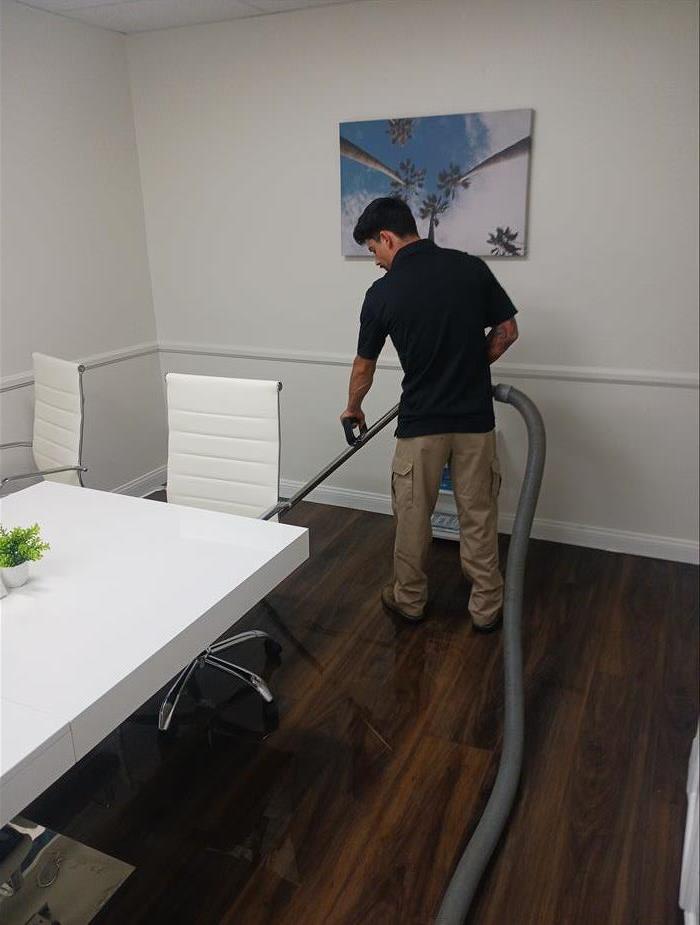 SERVPRO technician cleaning and restoring a flooded room, making sure your property is quickly and safely returned to its pre-damage state.
SERVPRO technician cleaning and restoring a flooded room, making sure your property is quickly and safely returned to its pre-damage state.
Water damage can occur suddenly, whether from a burst pipe, storm flooding, or a roof leak. The effects can be overwhelming, leading to significant structural damage, mold growth, and costly repairs. Quick action is crucial to minimize long-term issues, and SERVPRO is here to help every step of the way.
Why Choose SERVPRO for Water Damage Restoration?
At SERVPRO, we understand how stressful and disruptive water damage can be. Our expert team is here 24/7 to restore your property and peace of mind. Here’s how we can assist:
- 24/7 Emergency Response: Water damage doesn’t follow a schedule, and neither do we. Our team is available around the clock to respond to your emergency.
- Comprehensive Water Extraction: Using industrial-grade equipment, we quickly remove standing water to prevent further damage and deterioration.
- Thorough Drying & Dehumidification: Our advanced drying techniques help remove all moisture from walls, floors, and ceilings to prevent mold and additional damage.
- Cleaning & Sanitization: Once water is removed, we clean and sanitize affected areas to eliminate bacteria and prevent odors.
- Complete Restoration Services: Whether it's repairing structural damage, replacing flooring, or rebuilding rooms, SERVPRO restores your home to its pre-damage state.
Signs You Need Water Damage Restoration
If you've experienced any of these signs, it's time to act:
- Water stains on ceilings, walls, or floors
- Musty or moldy odors
- Damp or wet carpeting
- Warped or buckling floors
- Visible mold growth
Prevent Future Water Damage
While SERVPRO is here to help when disaster strikes, you can also take steps to prevent water damage:
- Inspect Plumbing: Regularly check pipes for leaks and maintain your water heater.
- Clean Gutters & Downspouts: Ensure water can flow freely away from your home.
- Install a Sump Pump: If you live in an area prone to flooding, a sump pump can help direct water away from your home.
- Monitor Roof Condition: Check for cracks or missing shingles that could lead to leaks.
Addressing Storm Damage: SERVPRO of Woodland Hills is Here to Help®
1/3/2025 (Permalink)
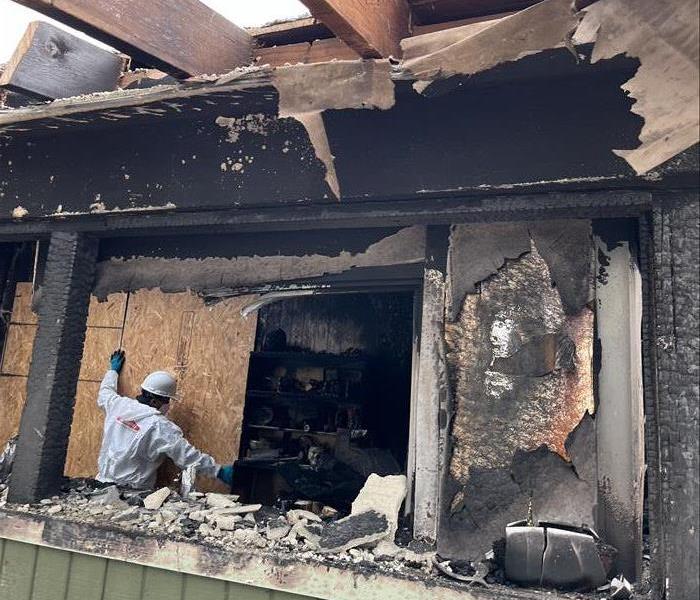 The technician is wearing uniforms and working efficiently in the midst of debris and visible damage to the house.
The technician is wearing uniforms and working efficiently in the midst of debris and visible damage to the house.
Storm damage can be devastating, with layers of destruction that require immediate attention to prevent further harm to your property. One of the most challenging areas to manage is often your flooring and carpeting, as water can seep into these materials, causing long-lasting damage if not addressed promptly. At SERVPRO of Woodland Hills, our professional technicians are trained to respond quickly, beginning extraction and drying efforts as soon as we arrive. We work around the clock to minimize secondary damage and protect your property.
In addition to addressing the immediate damage, our contents department will assess your belongings to determine what can be salvaged. If necessary, we will conduct a pack-out to ensure your personal items are safely stored while the restoration process takes place. Our experienced team of qualified restoration technicians, all accredited by the Institute of Inspection Cleaning and Restoration Certification (IICRC), provides focused cleaning, drying, and secure storage of your valuables in our climate-controlled facility.
Flooding and water damage can be a nightmare for homeowners and business owners alike, and the longer you wait to address it, the worse the effects become. Prompt action is key to minimizing damage and returning your property to its pre-disaster state. SERVPRO of Woodland Hills is here to restore your property and belongings with care and professionalism.
If you're dealing with the aftermath of a storm, call SERVPRO of Woodland Hills. We’ll make your loss "Like it never even happened."
Fire Restoration: Helpful tips 12/2024
12/19/2024 (Permalink)
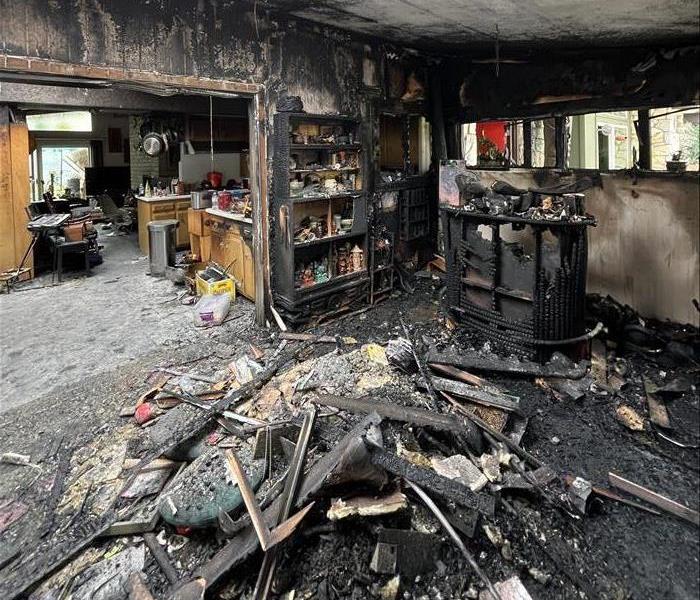 Fire Loss that occurred in a home serviced by our SERVPRO office!
Fire Loss that occurred in a home serviced by our SERVPRO office!
Experiencing a fire can be devastating. Beyond the flames, your property may suffer from smoke and soot damage, as well as water damage from firefighting efforts.
At SERVPRO, we understand the urgency of the situation. Our team of certified professionals is equipped to handle the complexities of fire restoration, ensuring a swift and effective recovery.
Here's a glimpse into our typical process:
Immediate Action: When disaster strikes, contact us immediately. Our specialists will gather essential information to quickly assess the situation and mobilize the necessary resources.
Thorough Inspection: We conduct a meticulous inspection of the affected areas to accurately determine the extent of fire, smoke, and water damage. This assessment guides the development of a customized restoration plan.
Emergency Protection: Fire damage can compromise your property's security. We swiftly address critical issues like broken windows, damaged roofs, and compromised walls with emergency board-up and roof-tarping services.
Smoke and Soot Removal: Our advanced equipment and techniques effectively remove smoke and soot residue from surfaces, including walls, ceilings, floors, and personal belongings.
This is just a starting point. We offer a comprehensive range of fire restoration services tailored to your specific needs.
Contact us today at (818)882-4556/ (818)881-3636 to learn more about how SERVPRO can help you recover from fire damage and restore your property to its preloss condition.
Mold and Moisture Control in Commercial Buildings: A Vital Imperative
7/18/2024 (Permalink)
Commercial buildings, bustling with activity and occupancy, are susceptible to mold growth due to various factors such as poor ventilation, moisture intrusion, and high humidity levels. Mold can cause risk to occupants but also can lead to structural damage and financial losses for businesses. As such, mold and moisture control in commercial buildings is a vital imperative for maintaining a safe and productive indoor environment. In this blog, we'll explore the importance of mold and moisture control in commercial buildings and discuss strategies for effective prevention and remediation.
Understanding the Risks of Mold in Commercial Buildings
Mold thrives in environments with moisture and organic materials, making commercial buildings susceptible to contamination, especially in areas such as bathrooms, kitchens, basements, and storage areas. Mold growth not only compromises indoor air quality but can cause risks to occupants if not addressed properly. Additionally, mold infestations can lead to property damage, staining, odors, and potential liability issues for businesses.
Importance of Moisture Control
Moisture control is critical for preventing mold growth and maintaining a healthy indoor environment in commercial buildings. Effective moisture control measures help reduce humidity levels, prevent water intrusion, and mitigate the risk of mold contamination. Some key strategies for moisture control in commercial buildings include:
- Proper Ventilation: Ensure adequate ventilation in areas prone to moisture accumulation, such as bathrooms, kitchens, and laundry rooms. Install exhaust fans, ventilation systems, and air conditioning units to remove excess moisture from indoor spaces and improve airflow.
- Regular Maintenance: Implement routine maintenance practices to identify and address potential sources of moisture, such as leaking pipes, roof leaks, condensation issues, and plumbing failures. Promptly repair water leaks and address drainage problems to prevent water intrusion and moisture buildup.
- Humidity Monitoring: Monitor indoor humidity levels regularly using hygrometers or humidity sensors. Maintain indoor humidity levels below 60% to inhibit mold growth and create an inhospitable environment for mold spores.
- Waterproofing: Implement waterproofing measures in areas susceptible to water intrusion, such as basements, crawl spaces, and foundation walls. Seal cracks, gaps, and openings to prevent water infiltration and moisture penetration into building structures.
Mold Prevention Strategies
In addition to moisture control, proactive mold prevention strategies are essential for safeguarding commercial buildings against mold contamination. Some effective mold prevention measures include:
- Regular Inspections: Conduct regular inspections of commercial buildings to identify signs of moisture damage, water leaks, and mold growth. Inspect building components such as roofs, windows, doors, walls, and HVAC systems for signs of water intrusion and mold contamination.
- Prompt Remediation: Address water damage and moisture issues promptly to prevent mold growth. Implement swift mitigation and remediation efforts to remove excess water, dry affected areas, and prevent mold proliferation.
- Educating Occupants: Educate building occupants about the importance of moisture control, mold prevention, and proper maintenance practices. Encourage occupants to report any signs of water damage, leaks, or mold growth promptly to facility management for timely intervention.
- Professional Assistance: Engage certified mold remediation specialists to conduct comprehensive mold inspections, remediate contamination, and implement preventive measures. Professional expertise and resources are essential for ensuring thorough mold prevention and remediation efforts in commercial buildings.
Mold and moisture control in commercial buildings is essential for maintaining a safe, healthy, and productive indoor environment for occupants and protecting the integrity of building structures. With a comprehensive approach to mold and moisture control, commercial building owners and facility managers can safeguard their investment and uphold the reputation and credibility of their businesses. Trust the experienced services, trust SERVPRO of Woodland Hills for your mold remediation services.
Salvaging vs. Replacing: What to Consider After Water Damage
6/12/2024 (Permalink)
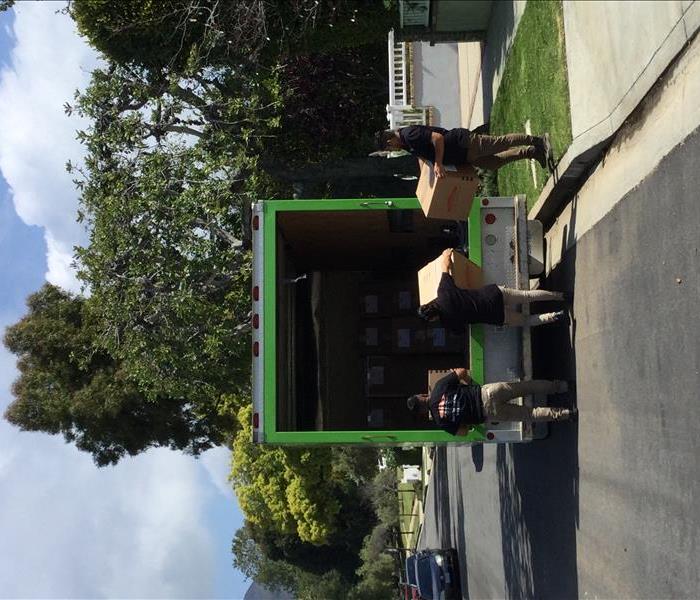 If you're dealing with water damage, don't hesitate to contact SERVPRO for expert assistance and reliable restoration services.
If you're dealing with water damage, don't hesitate to contact SERVPRO for expert assistance and reliable restoration services.
Water damage can wreak havoc on your home or business, leaving you with the daunting task of deciding what to salvage and what to replace. As a leading provider of water damage restoration services, SERVPRO® understands the importance of making informed decisions during such challenging times. In this blog post, we'll explore the factors to consider when determining whether to salvage or replace items affected by water damage.
Extent of Damage
The first step is to assess the extent of the damage. Items submerged in water for an extended period may suffer irreversible damage, especially porous materials like carpets, drywall, and insulation. Hardwood floors, electronics, and upholstered furniture are also prone to severe damage. If the damage is extensive or poses health risks (such as mold growth), replacement may be the best option.
Value and Sentimental Importance
Consider the value and sentimental importance of the items affected by water damage. Items with sentimental value, such as family heirlooms or irreplaceable photographs, may warrant efforts to salvage them, even if the damage is significant. Conversely, items of lesser value or those easily replaceable may be better off replaced.
Cost of Restoration
Assess the cost of restoring damaged items compared to the cost of replacement. In some cases, restoration may be more cost-effective, especially for items with high monetary or sentimental value. However, if the cost of restoration exceeds the value of the item or if the item can be easily replaced at a lower cost, replacement may be the better option.
Health and Safety Concerns
Water damage can compromise the structural integrity of buildings and pose health risks due to mold and bacteria growth. Items that cannot be adequately cleaned and sanitized may pose health hazards if retained. Additionally, water-damaged electrical appliances and wiring can pose safety risks and should be replaced to prevent accidents.
Professional Assessment
Seek the expertise of a professional water damage restoration company like SERVPRO to assess the damage and provide recommendations. Our trained technicians have the knowledge, experience, and specialized equipment to accurately evaluate the extent of water damage and recommend the most appropriate course of action for salvaging or replacing affected items.
The decision to salvage or replace items after water damage depends on various factors, including the extent of damage, value and sentimental importance, cost of restoration, health and safety concerns, and professional assessment. By carefully considering these factors, you can make informed decisions to minimize losses and restore your property to its pre-damage condition. If you're dealing with water damage, don't hesitate to contact SERVPRO for expert assistance and reliable restoration services.
Protecting Your Business from Storm-Related Disruptions
5/15/2024 (Permalink)
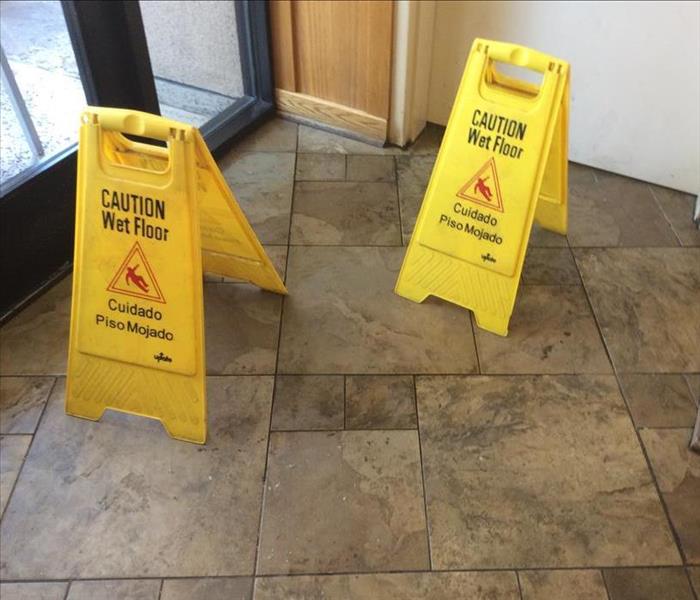 At SERVPRO®, we're committed to helping businesses mitigate the risks associated with storm-related disruptions.
At SERVPRO®, we're committed to helping businesses mitigate the risks associated with storm-related disruptions.
As a business owner, you understand the importance of keeping your operations running smoothly. However, when storms strike, they can wreak havoc on your business and cause significant disruptions. From power outages to property damage, storms can pose various challenges that may impact your bottom line. At SERVPRO®, we're committed to helping businesses mitigate the risks associated with storm-related disruptions. Here are some essential tips to safeguard your business and minimize downtime during inclement weather:
- Develop a Comprehensive Emergency Plan: Preparation is key to mitigating the impact of storms on your business. Develop a detailed emergency plan that outlines procedures for employee safety, property protection, and business continuity. Ensure that all employees are familiar with the plan and conduct regular drills to practice emergency protocols.
- Invest in Backup Power Sources: Power outages are common during severe storms, which can halt your business operations. Invest in backup power sources such as generators to keep essential systems running during emergencies. Consider installing surge protectors to safeguard electronic equipment from power surges.
- Secure Your Property: Protect your business property from storm damage by taking proactive measures. Trim trees and branches that could potentially fall on your building during high winds. Install storm shutters or board up windows to prevent glass breakage. Additionally, inspect your roof for any signs of damage and make necessary repairs to prevent leaks.
- Implement Remote Work Solutions: Enable your employees to work remotely during storm-related disruptions to ensure continuity of operations. Utilize cloud-based software and collaboration tools to facilitate remote work communication and project management. By allowing employees to work from home, you can maintain productivity despite adverse weather conditions.
- Partner with a Reliable Restoration Company: In the event of storm damage to your business property, it's crucial to have a trusted restoration company on standby. SERVPRO offers 24/7 emergency response services to help businesses recover quickly from storm-related disasters. Our team of trained professionals is equipped to handle everything from water damage restoration to mold remediation, ensuring minimal downtime for your business.
Don't let storms catch your business off guard. By implementing these proactive measures and partnering with SERVPRO, you can protect your business from storm-related disruptions and maintain continuity of operations. For more information on our storm damage restoration services, contact SERVPRO today. Stay prepared, stay protected!
Differences in fire damage restoration for homes versus commercial properties
4/19/2024 (Permalink)
Fire damage is a distressing event, and whether it strikes a home or a commercial property, the aftermath can be overwhelming. At SERVPRO®, we understand the unique challenges posed by fire damage, and in this blog post, we'll delve into the critical differences in the restoration process for homes versus commercial properties.
Scale Matters
The primary distinction between home and commercial fire damage restoration lies in the scale of the incident. Commercial properties are often larger and more complex, with multiple floors and intricate layouts. This requires a meticulous approach to assess and address the damage comprehensively.
For homes, the focus tends to be on specific areas like bedrooms, kitchens, and living spaces. In both cases, a swift response is essential, but the scope of the restoration project significantly influences the strategies employed.
Business Interruption vs. Personal Disruption
Commercial fire damage not only impacts the property itself but also disrupts business operations. Time is of the essence in restoring commercial spaces to minimize downtime and financial losses. Our team at SERVPRO is well-versed in working efficiently to restore normalcy to businesses.
Conversely, home fire damage, while emotionally distressing, usually doesn't have the same immediate financial implications. The focus here is on personal belongings and creating a safe environment for the homeowners.
Code Compliance Challenges
Commercial properties must adhere to strict building codes and regulations. During the restoration process, our team pays meticulous attention to ensuring that all repairs and renovations comply with these codes. This may involve working closely with local authorities to secure necessary permits and approvals.
While homes also have building codes to consider, the regulatory landscape is often less complex. Our SERVPRO experts ensure that all restoration work aligns with local building requirements for both homes and commercial properties.
Specialized Equipment and Expertise
Commercial properties often house specialized equipment and materials that require a unique approach to restoration. Our SERVPRO technicians are trained to handle these intricacies, whether it's a manufacturing facility or a retail space.
Residential properties, on the other hand, may involve more personal items with sentimental value. Our team employs a compassionate approach to salvaging and restoring these belongings, recognizing their irreplaceable importance to homeowners.
At SERVPRO, we comprehend that fire damage, be it at home or in a commercial setting, is a traumatic experience. Our seasoned professionals are equipped with the knowledge and expertise to navigate the unique challenges posed by each scenario. By understanding the differences in restoration needs for homes versus commercial properties, we ensure a tailored approach that facilitates a smooth and efficient recovery process. When the flames subside, SERVPRO stands ready to restore both homes and businesses back to pre-fire conditions.
Mold in Rental Properties: Tenant and Landlord Responsibilities
3/13/2024 (Permalink)
As a trusted provider of restoration and cleaning services, we understand that mold can be a pesky issue in rental properties. Today, we're diving into the responsibilities of both tenants and landlords when it comes to mold in rental spaces. Let's get into the nitty-gritty and help you navigate this common challenge.
Identifying Mold
First things first – mold is not a welcome houseguest. It thrives in damp and humid environments, making rental properties susceptible to its growth. As a tenant, keep an eye out for any signs of mold, such as musty odors, discolored patches on walls or ceilings, and signs even water damage.
Tenant Responsibilities
Tenants play a crucial role in preventing and addressing mold issues. Regularly inspect your living space for leaks and moisture, promptly reporting any concerns to your landlord. Keep the property well-ventilated to reduce humidity, and if you spot any mold, refrain from trying to tackle it yourself – report it immediately.
Landlord Responsibilities
Landlords, this one's for you! Ensuring your rental property is mold-free is not only beneficial for your tenants' well-being but also safeguards the structural integrity of your investment. Conduct routine inspections to identify and address any potential sources of moisture. Promptly respond to tenant reports of mold, and hire professionals like SERVPRO® to conduct thorough mold remediation if needed.
Communication is Key
Open communication between tenants and landlords is vital in managing mold concerns. Tenants, don't hesitate to notify your landlord at the first sign of mold, and landlords, be proactive in addressing these reports promptly. Together, you can create a living environment that's mold neutral.
Prevention Tips
Prevention is the best cure, right? Encourage tenants to use exhaust fans, address leaks immediately, and maintain proper ventilation. Landlords, consider investing in dehumidifiers for properties in humid climates, and educate your tenants about mold prevention best practices.
Mold in rental properties is a shared responsibility, and effective communication is key to resolving the issue. By staying vigilant, promptly addressing concerns, and taking preventive measures, tenants and landlords can create an ideal living environment for everyone. If mold becomes a persistent problem, don't hesitate to reach out to SERVPRO for professional assistance. We're here to help you keep your rental property mold-free and thriving!
Repair or Replace? How to Assess Water-Damaged Items
2/22/2024 (Permalink)
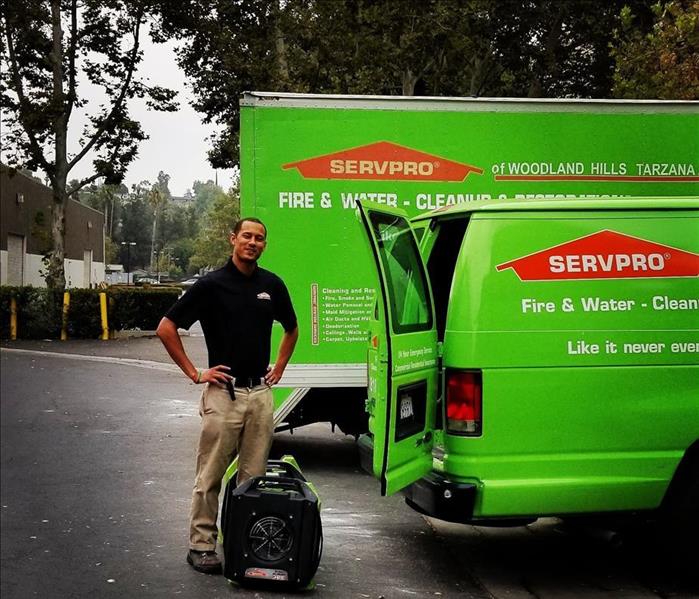 Restoration experts, such as our SERVPRO® team, can provide valuable insights and guidance on the best course of action.
Restoration experts, such as our SERVPRO® team, can provide valuable insights and guidance on the best course of action.
Water damage can wreak havoc on belongings, leaving homeowners faced with the dilemma of whether to repair or replace affected items. As seasoned professionals in the restoration industry, we often encounter numerous scenarios involving water-damaged items and understand the considerations in deciding between repair and replacement. Let's explore what can be salvaged after water damage and when it's best to opt for replacement.
1. Quick Assessment
Upon encountering water-damaged items, it's essential to conduct a quick assessment of the damage. Items vary in material, resilience, and susceptibility to water. Evaluate the extent of the damage, considering factors like the item's material, sentimental value, and the severity of water exposure.
2. Factors Influencing Salvageability
Some materials, like solid wood or certain metals, can withstand water damage better than others. Porous materials such as fabric, upholstery, or particleboard may be more challenging to salvage. The duration and level of exposure to water also play a crucial role. Items submerged in water for an extended period are more likely to suffer irreparable damage. Clean water from a pipe leak might pose fewer risks compared to contaminated water from floods or sewage backups. Contaminated water most often renders items unsalvageable due to potential health hazards.
3. Salvaging Strategies
- Professional Restoration Services: Consider consulting restoration professionals, such as SERVPRO of Woodland Hills, for items of high value or sentimental significance. Our team has the expertise and highly advanced equipment to repair water-damaged items effectively.
- Thorough Drying and Cleaning: For less severe damage, thorough drying and cleaning might salvage certain items. Use fans, dehumidifiers, and gentle cleaning solutions to remove moisture and dirt.
- DIY Repair: Some items, like wooden furniture or non-electrical appliances, might be salvageable through DIY efforts. Quick action and proper drying techniques are crucial.
4. When Replacement is the Best Option
- Severe Damage: Items extensively damaged or warped beyond repair, such as swollen particleboard furniture or irreparably warped electronics, might warrant replacement.
- Risks Involved: Items exposed to contaminated water or those prone to mold growth may pose a variety of risks, making replacement a safer choice.
- Cost Consideration: Sometimes, the cost of restoration exceeds the item's value or replacement cost. In such cases, opting for replacement might be cheaper and more practical.
5. Professional Opinion
When uncertain about the salvageability of valuable or irreplaceable items, seek professional opinions. Restoration experts, such as our SERVPRO® team, can provide valuable insights and guidance on the best course of action.
In conclusion, the decision to repair or replace water-damaged items depends on several factors. A quick assessment, considering material type, the extent of damage, and potential risks involved is highly important. While some items can be salvaged through professional restoration or DIY efforts, others may require replacement for safety, cost, or irreparable damage. Prioritize safety, especially when dealing with potentially contaminated items, and seek expert advice when in doubt about salvaging water-damaged belongings.
 Close-up image showing mold growth on a wall with visible black spots and discoloration, indicating the presence of moisture damage.
Close-up image showing mold growth on a wall with visible black spots and discoloration, indicating the presence of moisture damage.


 24/7 Emergency Service
24/7 Emergency Service



